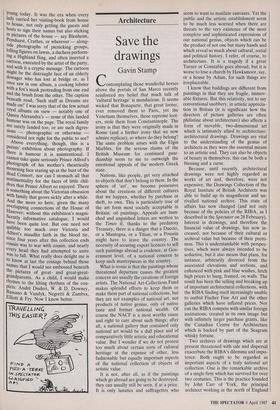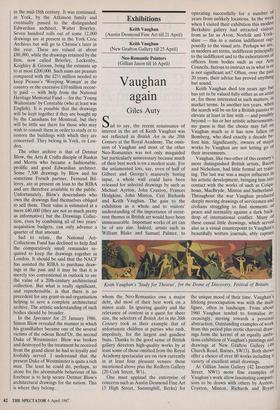Architecture
Save the drawings
Gavin Stamp
Contemplating those wonderful horses above the portals of San Marco recently reinforced my belief that much talk of `cultural heritage' is mendacious. It seems wicked that Bonaparte, that great looter, ever removed them to Paris, yet the Venetians themselves, those supreme loot- ers, stole them from Constantinople. The irony is that they were originally made in Rome (and a further irony that we now admire replicas); so where do they belong? The same problem arises with the Elgin Marbles, for the serious claims of the British Museum for continued guar- dianship seem to me to outweigh the emotional appeals of the modern Greek state.
Nations, like people, get very attached to objects that don't belong to them. In the sphere of 'art', we become possessive about the creations of different cultures that we happen, whether by purchase or theft, to own. This is particularly true of the art form most socially acceptable in Britain: oil paintings. Appeals are laun- ched and anguished letters are written to the Times if, thanks to the predatory Treasury, there is a danger that a Duccio, or a Mantegna, or a Titian, or a Poussin might have to leave the country. The necessity of securing export licences to sell such paintings abroad is evidence, at Gov- ernment level, of a national concern to keep such masterpieces in the country. What is ironic is that the paintings whose threatened departure causes the greatest concern are usually the creations of foreign artists. The National Art-Collections Fund makes splendid efforts to keep them or make them part of national collections, but they are not examples of national art, not products of native genius, only of native taste and former national wealth. Of course the NACF is a most worthy cause and right to care about such things; after all, a national gallery that contained only national art would be a dull place and of comparatively little artistic and educational value. But I wonder if we do not protest too much about certain sorts of cultural heritage at the expense of other, less fashionable but equally important aspects of the national collection of objects of artistic value.
It is not, after all, as if the paintings which go abroad are going to be destroyed: they can usually still be seen, if at a price. It is only lunatics and suffragettes who seem to want to mutilate canvases. Yet the public and the artistic establishment seem to be much less worried when there are threats to the very existence of the most complete and sophisticated expressions of our national genius, objects which can be the product of not one but many hands and which reveal so much about cultural, social and political history. I refer, of course, to architecture. It is a tragedy if a great Turner or Constable goes abroad, but it is worse to lose a church by Hawksmoor, say, or a house by Adam, for such things are irreplaceable.
I know that buildings are different from paintings in that they are fragile, immov- able fixtures. But this relativity, not to say conventional snobbery, in artistic apprecia- tion in Britain (it is significant how the directors of picture galleries are often philistine about architecture) also affects a form of movable, two-dimensional art which is intimately allied to architecture: architectural drawings. Drawings are vital to the understanding of the genius of architects as they were the essential means to an artistic end. They can also be objects of beauty in themselves; this can be both a blessing and a curse.
Because, until recently, architectural drawings were not highly regarded as works of art and, therefore, were not expensive, the Drawings Collection of the Royal Institute of British Architects was able to build up its magnificent and un- rivalled national archive. This state of affairs has now changed (and not only because of the policies of the RIBA, as I described in the Spectator on 28 February). Interest in drawings, and therefore the financial value of drawings, has now in- creased, not because of their cultural or archival value but because of their pretti- ness. This is understandable with perspec- tives, which were always intended to be seductive, but it also means that plans, for instance, arbitrarily divorced from the associated elevations and sections, and enhanced with pink and blue washes, fetch high prices to hang, framed, on walls. The result has been the selling and breaking up of important architectural collections, with the RIBA finding itself increasingly unable to outbid Fischer Fine Art and the other galleries which have inflated prices. Nor can the RIBA compete with similar foreign institutions, created in its own image but with infinitely larger purchase grants, like the Canadian Centre for Architecture which is backed by part of the Seagram whisky fortune.
Two archives of drawings which are at present threatened with sale and dispersal exacerbate the RIBA's dilemma and impo- tence. Both ought to be regarded as important aspects of a truly national art collection. One is the remarkable archive of a single firm which has survived for over two centuries. This is the practice founded by John Carr of York, the principal architect working in the north of England in the mid-18th century. It was continued, in York, by the Atkinson family and eventually passed to the distinguished Edwardian architect, Walter Brierley. Seven hundred rolls out of some 12,000 drawings are at present in the York Civic Archives but will go to Christie's later in the year. These are valued at about £80,000, while the drawings retained by the firm, now called Brierley, Leckenby, Keighley & Groom, bring the estimate up to at most £200,000. Such sums are peanuts compared with the £21/2 million needed to keep Picasso's 'Weeping Woman' in the country or the excessive £10 million recent- ly paid — with help from the National Heritage Memorial Fund — for the 'Young Waltonians' by Constable (who at least was English). It is possible that the drawings will be kept together if they are bought up by the Canadians for Montreal, but they will be little use there for those who may wish to consult them in order to study or to restore the buildings with which they are concerned. They belong in York, or Lon- don.
The other archive is that of Detmar Blow, the Arts & Crafts disciple of Ruskin and Morris who became a fashionable, prolific and good Edwardian architect. Some 7,500 drawings by Blow and his sometime French partner, Fernand Bil- lerey, , are at present on loan to the RIBA and are therefore available to the public. Unfortunately, Blow's descendants who own the drawings find themselves obliged to sell them. Their value is estimated at a mere £40,000 (they are not so much pretty as informative) but the Drawings Collec- tion, even by combining all of two years' acquisition budgets, can only advance a quarter of that amount.
Sad to relate, the National Art- Collections Fund has declined to help find the comparatively small remainder re- quired to keep the drawings together in London. It should be said that the NACF has assisted the RIBA to purchase draw- ings in the past and it may be that it is merely too conventional in outlook to see the value of a 20th-century architectural collection. But what is really significant, and reprehensible, is that there is no precedent for any grant-in-aid organisation helping to save a complete architectural archive. The artistic understanding of such bodies should be broader.
In the Spectator for 25 January 1986, Simon Blow revealed the manner in which his grandfather became one of the several victims of the odious Bend'Or, the second Duke of Westminster. Blow was broken and destroyed by the treatment he received from the grand client he had so loyally and foolishly served. I understand that the present Duke of Westminster is quite a rich man. The least he could do, perhaps, to atone for the abominable behaviour of his forebear is to help secure Detmar Blow's architectural drawings for the nation. This is where they belong.



























































 Previous page
Previous page